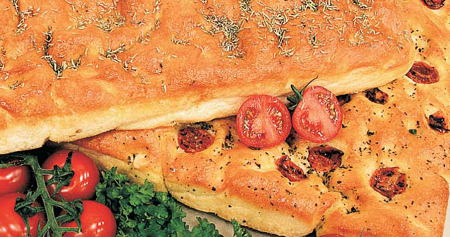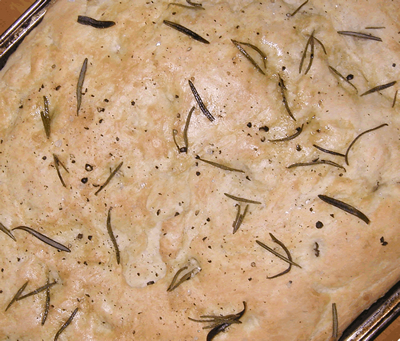Focaccia is a style of bread made popular in Italy, and spreading around the world wherever Italian settlers and traders have formed communities. The bread is relatively flat, usually quite plain inside, but topped with olive oil and herbs, and occasionally with sliced olives on top. A range of varieties of focaccia exist, and in the 21st century new varieties have been created due to the versatility of the basic recipe.
Most historians believe Focaccia originated with either the Etruscans of North Central Italy prior to the Roman Empire forming, or in Ancient Greece at the beginning of the first millennium BC, though flat unleavened bread has been made throughout the Middle East and extending to Persia for this long as well so identifying a specific culture responsible for the first focaccia loaves is almost impossible. That said, focaccia is slightly different in that the loaf does rise slightly so is not a traditional unleavened bread, and the focaccia recipe is mostly unknown in the Middle East, yet has a history of being prepared in Turkey, Greece, Italy, France, and Spain.

Historically focaccia was unleavened, the recipe rises naturally in the right climate, and this gives a further clue to its origins, the further inland one goes the less dense the air becomes, and considering so much of the inland Mediterranean is quite mountainous we can speculate that it was inland people who first created focaccia. Contrast this with Phoenician people who originated in what is now coastal Lebanon and coastal Syria, and then spread throughout the Mediterranean by 1100 BC weren’t known to eat bread with the same properties as focaccia. In coastal areas a small amount of yeast need to be added to make the bread rise, otherwise a traditional flat bread is the result.
We do know that the name Focaccia is directly derived from the Roman words “panis focacius”. Panis simply means bread, and shouldn’t be confused with the modern English word pan, which whilst used to bake bread is actually derived from the Latin word patina meaning dish. Focacius is the Latin word for center or fireplace. Linguists theorize that since the fireplace was in the center of the house that the word could be used interchangeably. Focaccia in Roman times was cooked in the ashes of a fire rather than on a tray above the fire, so the translation seems correct.
Romans would mix up a simple recipe of rough flour, olive oil, water, a very small quantity of yeast, and salt, and may have been seasoned with other herbs but in most cases was probably quite plain, this was then baked in the ‘focacius’. In Roman times focaccia was used as a dipping bread, usually being torn apart by hand and dipped into salty soups made quite simply from water, vinegar, and possibly olive oil. In today’s times this doesn’t sound very appetizing but for people accustomed to long hours of physical labor it provided nourishment and was a cheap and filling meal.

During the Roman ceremony of Saturnalia, which many historians to be the ancient ancestor of modern Christmas celebrations, a pig was sacrificed to please the Roman gods. In the later years of the Roman Empire a Lord of Misrule was chosen instead who would be feted upon while all the time wearing the costume of a pig. The Lord of Misrule was always a young man who was expected to act the part of a clown. A focaccia bread would be baked that included a fava bean, and the lucky man to find the bean in his piece of bread became lord for the duration of the ceremony.
The basic recipe for focaccia spread with the Romans to France and Spain where it became a popular bread to bake primarily in less well off areas initially. In fact focaccia style breads were used extensively to feed slaves in the Roman Empire and a stigma still exists today in some countries. In Spain, pan de hogaza, the peasant’s staple bread which is made in a similar way to Roman panis focacius is also known as pan rustica, a homemade bread typically made in the countryside amongst the very poor.
In France focaccia style recipes such as fouaisse or foisse hat are made in Burgundy are considered a daily bread by a significant part of the population and in bakeries are still one of the most popular breads sold. Similarly in the Provence and Languedoc regions fogassa as it is known, focaccia breads are still very popular with bakeries and supermarkets all selling more fogassa than the French baguette, a bread considered typical for France.
In more recent times, at least since the medieval ages, the Catholic Church has used focaccia quite extensively during religious festivities, most often during the Eucharist, and the unleavened recipe of focaccia is most commonly used, primarily owing to Christ’s use of unleavened bread during The Last Supper. The tradition derives from the ready availability of focaccia bred and it’s simple, and some say pure recipe untainted with foreign ingredients, and thus coming to represent Christ’s flesh which of course is considered utterly pure and free of sin.
In the 20th century Italian immigrants to the United States brought with them recipes for pizza, bruschetta, grissini, and of course focaccia. Arguably focaccia is no longer strictly the preseve of Italian communities, nowadays it can be found in almost all bakeries and supermarkets. With a wide variety of seasonings, focaccia bread makes a very tasty sandwich bread, and is frequently served with cheese and ham fillings.
Comments are closed